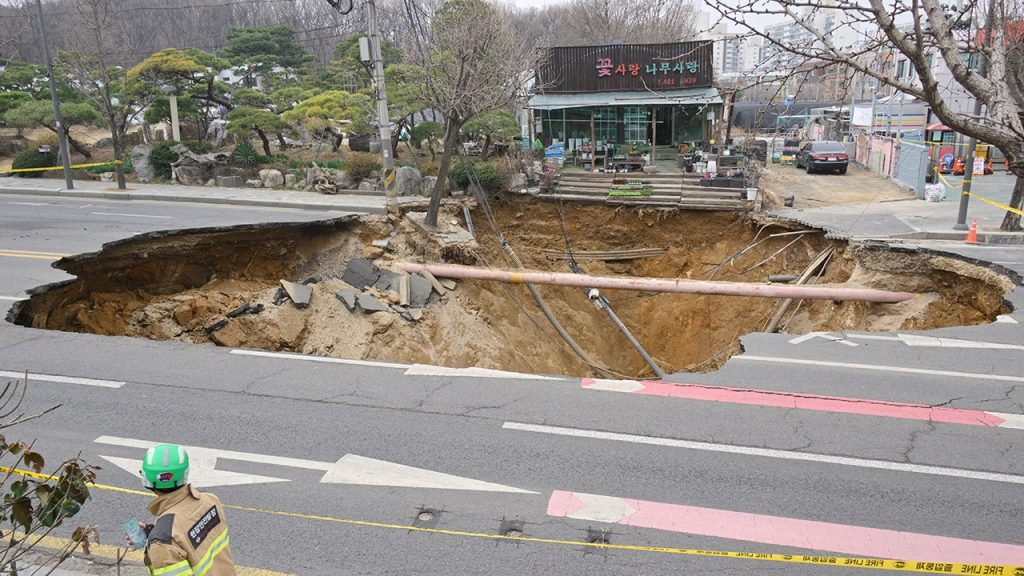A tragic incident in Seoul, South Korea, unfolded when a massive sinkhole resulted in the death of a motorcyclist. The sinkhole, measuring approximately 65 feet wide and deep, appeared suddenly at an intersection in the Myeongil-dong neighborhood on Monday afternoon, swallowing the biker and injuring a passing motorist. Despite emergency response efforts extending over 18 hours, officials confirmed the victim was found deceased the following day, leading to investigations into the sinkhole’s cause and implications for public safety.
| Article Subheadings |
|---|
| 1) Incident Overview: The Sinkhole Emergence |
| 2) Identification of the Victim and Rescue Operations |
| 3) Emergency Response: Challenges Faced |
| 4) Injuries and Impact on Other Individuals |
| 5) Investigative Follow-Up and Safety Concerns |
Incident Overview: The Sinkhole Emergence
On a quiet afternoon on March 25, 2025, a critical situation emerged in the Myeongil-dong neighborhood of Seoul, where a substantial sinkhole opened unexpectedly at a traffic intersection. This sinkhole measured approximately 65 feet in both width and depth, creating significant concern among local residents and officials alike. The hole formed rapidly, catching pedestrians and motorists off guard. Such phenomena can occur suddenly and are often the result of underground water erosion, sewer failures, or geological instability. Locals noted a series of concerning sounds prior to the incident, raising alarms about the structural integrity of the surrounding infrastructure.
Identification of the Victim and Rescue Operations
The deceased motorcyclist was identified as a man in his 30s, whose identity has yet to be publicly disclosed pending notification of family members. Following the incident, emergency responders quickly mobilized, attempting to locate the individual who had vanished into the sinkhole. By noon the following day, the emergency officer, Kim Chang Seob, announced the tragic finding of the victim’s body, still equipped with a motorcycle helmet and boots, alongside his Japanese-made motorcycle and cell phone, which had been recovered during the search process.
Emergency Response: Challenges Faced
The rescue operations were notably challenging, taking first responders nearly 18 hours to recover the victim. Emergency teams faced significant obstacles, including the need to pump out water from the sinkhole and excavate through substantial amounts of dirt and debris. Officer Kim indicated that various tools, including excavators and shovels, were essential in their efforts to navigate the hazardous conditions presented by the collapsed ground. Despite the difficult circumstances, the rescue team persisted in their operations throughout the night to locate the victim, reflecting their commitment to public safety and emergency response protocols.
Injuries and Impact on Other Individuals
In addition to the motorcyclist, a woman driving a van at the time of the incident suffered minor injuries after her vehicle was caught in the sinkhole’s sudden emergence. Quick medical attention was provided, and she was evaluated at a local hospital. The incident not only affected the individuals directly involved but also raised alarms among the local community regarding the safety of road structures, particularly in an urban environment known for its heavy traffic and reliance on roadways.
Investigative Follow-Up and Safety Concerns
In the aftermath of this tragic event, authorities have initiated an investigation to determine the cause of the sinkhole. Such investigations often consider factors like poor drainage systems, geological surveys, and the state of existing infrastructure. Officials have emphasized the need for thorough assessments of similar areas within the city to mitigate potential risks and ensure public safety for residents and commuters. The incident has triggered a broader discussion about infrastructure maintenance and emergency preparedness, emphasizing the importance of proactive measures to prevent future occurrences of such nature.
| No. | Key Points |
|---|---|
| 1 | A motorcyclist died after being swallowed by a sinkhole in Seoul. |
| 2 | The sinkhole measured approximately 65 feet in both width and depth. |
| 3 | Rescue efforts lasted nearly 18 hours before the victim was found. |
| 4 | A passing female motorist sustained minor injuries in the incident. |
| 5 | Authorities are investigating the cause of the sinkhole for public safety concerns. |
Summary
This incident emphasizes the critical importance of infrastructure safety and emergency preparedness in urban settings. The unexpected appearance of the sinkhole serves as a somber reminder of potential risks faced by residents and commuters, underscoring the need for continued monitoring and maintenance of public roadways. With investigations ongoing, officials aim to uncover the reasons behind this tragic event and implement measures to prevent similar occurrences in the future.
Frequently Asked Questions
Question: What are the common causes of sinkholes?
Sinkholes can occur due to a variety of factors such as geological conditions, underground water erosion, aging infrastructure, and heavy rainfall. They often emerge in areas with limestone or other solubile rock formations.
Question: What safety measures can be implemented to prevent sinkhole-related incidents?
Municipalities can implement regular inspections and maintenance of roadways and drainage systems, invest in geological assessments, and improve monitoring systems to detect early signs of ground instability.
Question: How can individuals stay safe in areas prone to sinkholes?
In areas suspected of being prone to sinkholes, individuals should remain vigilant, report any unusual ground settling or cracking, and stay informed about local infrastructure health through municipal announcements and advisories.


